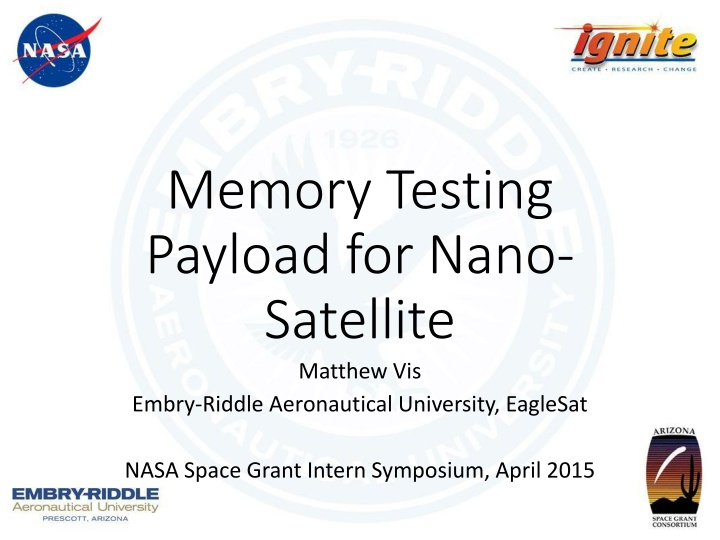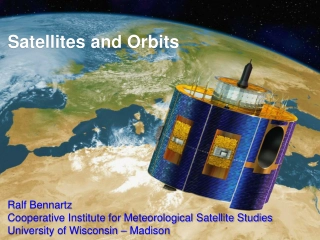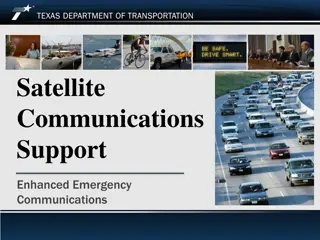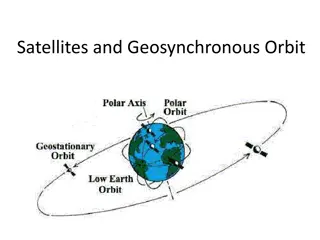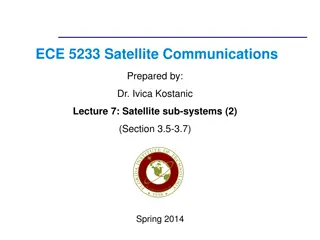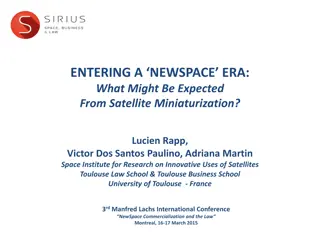Memory Testing Payload for Nano- Satellite
Effects of solar radiation on computer memory types, create testing payload for nano-satellite research, and analyze data upsets using software algorithms. Progress includes functional memory chips and defined communication protocols.
Download Presentation

Please find below an Image/Link to download the presentation.
The content on the website is provided AS IS for your information and personal use only. It may not be sold, licensed, or shared on other websites without obtaining consent from the author.If you encounter any issues during the download, it is possible that the publisher has removed the file from their server.
You are allowed to download the files provided on this website for personal or commercial use, subject to the condition that they are used lawfully. All files are the property of their respective owners.
The content on the website is provided AS IS for your information and personal use only. It may not be sold, licensed, or shared on other websites without obtaining consent from the author.
E N D
Presentation Transcript
Memory Testing Payload for Nano- Satellite Matthew Vis Embry-Riddle Aeronautical University, EagleSat NASA Space Grant Intern Symposium, April 2015
Overview Reasons for Research Research Options Detailed Research Plan Current Progress
Reasons for Research Measure and analyze effects of solar radiation on different types of computer memory Gain greater understanding of the limitations and applications of different types of computer memory Give undergraduate students exposure to creating embedded systems in non-critical space applications.
Research Options High altitude Balloon Payload Send payload on a balloon to gain greater access to radiation Limited in altitude and little increase in radiation levels Limited exposure time (1) Satellite Payload (Selected) Send as payload to small-scale satellite Difficult to organize launch, but helped provided by NASA Much greater exposure time and radiation levels (2) (1) http://public.media.smithsonianmag.com/legacy_blog/10_22_2013_world-view1.jpg (2) http://images.gizmag.com/hero/cubesat-missions-1.jpg
Detailed Research Plan Create Payload for testing five (5) types of computer memory Dynamic Random Access Memory (DRAM) Static Random Access Memory (SRAM) Flash Memory (Flash) Ferroelectric Random Access Memory (FRAM) Magneto-resistive Random Access Memory (MRAM) Test for memory data upsets using software algorithms.
Detailed Research Plan (cont.) Payload Block Diagram
Detailed Research Plan (cont.) Payload Software Algorithm
Current Progress Four (4) of the memory chips are functioning as expected Protocols and capabilities for communication to/from On-Board Computer functioning as expected Interface between Payload and On-Board Computer fully defined Algorithm fully defined and implemented for all error types currently identified Printed Circuit Board (PCB) design complete PCB with testing points still on order
Future Work Add fifth memory chip functionality (DRAM) Identify more types of errors to analyze and adapt or expand algorithm accordingly Develop testing procedures to ensure completeness and quality of both Software and Hardware Test capabilities with PCB that includes testing points Test interface with On-Board Computer Build and test flight-model
Determine Errors Algorithm
Analyze Errors Algorithm
